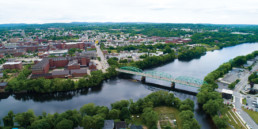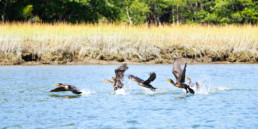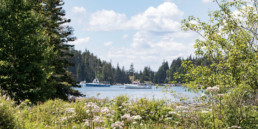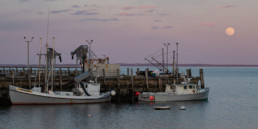More Than a Pile of Shells
A new understanding of Maine’s shell middens
BY CATHERINE SCHMITT
“These oyster beds were so productive that it gave a supply to all that wished for the period of many times 70 years, so that the shells of this food fish was piled up almost mountain high on the shore of a river bank for a long distance… Although the people stay around those oyster beds or near them almost the year round, but those who lived far away did not visit the place until just before the leaves began to fall, they then go there and gather oysters, clams and acorns for winter use…when harvest time comes the place contained many people from all parts of the country, and here they exchanged a great deal of information…”
—Joseph Nicolar, Life and Traditions of the Red Man
mon-u-ment. a lasting evidence, reminder, or example of someone or something notable or great… an identifying mark
—Merriam-Webster’s Collegiate Dictionary
Up a tidal river, around a blue-green bend where the banks begin to steepen, the wooded shoreline is interrupted by a tall white cliff. Weathered bits of shell and dust tumble down the exposed face, revealing layer upon layer of oyster shells.
Pockets of charcoal and fire-cracked rock are signs of human activity from millennia ago, when ancestors of the Wabanaki people came together to harvest oysters from the warm, brackish river in what is now known as Damariscotta and Newcastle. On both banks, they deposited the shells, one at a time, basketful by basketful, season after season. Eventually, the piles grew into small mountains some 30 feet tall.
Around 2,000 years ago, the local people stopped adding to the piles. Soil and trees grew over the tops, but the middens were massive and the river kept the edges washed clean, and they continued to attract attention after Europeans came on the scene.
Some thought perhaps the middens were a sign of a lost city, the famed Norumbega. Archaeologists, perpetuating beliefs of racial supremacy, believed the shell heaps to be evidence of a very ancient and long-lost people. Entrepreneurs estimated the volume and monetary worth of the minerals and artifacts contained in the middens.
They attacked the piles with shovels, trowels, and rakes, extracting thousands of objects from a single heap. They filled their pockets with shells and artifacts. They burned the shells for lime and carted wagonloads away for chicken feed. They dug out the things they deemed worth saving, and left the rest.
In their published reports, past archaeologists called the middens disorderly and unremarkable; they described the pottery as crude and poorly made, and the makers as mysterious people, cannibals or Esquimaux, perhaps.
Back at home in their towns and cities, the archaeologists presented their findings. “They are refuse piles of early man—their back-yards—just what a man’s back-yard of today, filled with old tin cans, hoop skirts, dirt heaps, and other rubbish would be if unearthed a thousand years hence,” said one. The crowd laughed and applauded—a response that revealed their thoughts about superiority and progress.
Historians and archaeologists interpreted the middens to be garbage piles, built a very long time ago. They speculated about how the piles were built and by whom. But not one of them ever asked why.
* * *
Last year at a University of Maine undergraduate research conference, a student presented a poster about Damariscotta River middens. Alice Kelley, a geoarchaeologist who uses geological techniques to study past interactions of people and climate and who was studying shell middens coastwide, fell into conversation with Jim Roscoe, who was also looking at the poster.
The giant shell heap reminded Roscoe, an anthropologist, of structures he knew from work in the South Pacific.
Roscoe spent two years in Papua New Guinea, among the Yangoru Boiken of East Sepik Province.
“The Yangoru Boiken are a densely populated people who practice horticulture and pig-exchange,” Roscoe explained. “They used to build large men’s cult houses with large sloping facades ornately decorated with painting and sculpture.”
Cult houses can reach enormous sizes in New Guinea, up to 100 feet at their apex and 600 feet long. Roscoe’s view is that these structures are an ingenious means for allied groups to keep the peace by demonstrating their strength—their size, the number of their allies, and their commitment to group interests.
It struck the two scientists that the Damariscotta River mounds might also be symbolic structures. Rather than dismissing the middens as mere garbage heaps, Kelley and Roscoe suggest that the middens had much more meaning to their human builders.
“There’s more to this than just a pile of shells,” said Kelley.
* * *
There are thousands of other shell heaps around the coast of Maine—but few are made of oysters, and none are so large. The Damariscotta River oyster piles are the largest middens on the East Coast north of Florida. Why are they so big? Oyster shells are large and durable, compared to the soft-shell clam shells that make up most middens. While the midden on the east side of the river was severely diminished by mining, it and other middens have survived because of the relative lack of development along the Maine coast. Also, the oyster middens sit on the edge of a river, 15 miles from the open ocean, protected from the rising seas and waves that have eroded middens in more exposed locations.
The Damariscotta middens are thickest at the water’s edge, but extend hundreds of feet into the forest. Discarded pottery and other artifacts from within and around the middens indicate people were living on site, not simply collecting and preparing shellfish. It was more than a fishing camp. People gathered there in seasons both warm and cold. They cooked and made pottery at the site and got water from a small stream. They ate berries and nuts; clams, fish, deer, seal, moose, and bear. And lots and lots of oysters.
The piles may have started out of accident or convenience.Or people could have intended from the outset to make their mark. They didn’t throw the shells back into the river, but instead built tall mounds, dumping shells on top and creating landmarks visible to people paddling up and down the river.
“There are lots of reasons why they’d want to make a shell pile large and noticeable,” said Kelley.
Were people trying to make a landmark visible to navigators? Were they trying to maintain peace, as Roscoe suggested?
These are the remains of structures built by people who wanted, perhaps, to send a message about their history of interaction with the land and sea.
Bonnie Newsom, assistant professor of anthropology at the University of Maine and a tribal citizen of the Penobscot Nation, said the middens could have been navigation aids, social boundary markers, resource markers, or multi-purpose features on the landscape.
“Rather than features of prestige or power, the middens might have served to signal a shared resource, an invitation of sorts to share in the Earth’s gifts to the people,” she said. “We know that Native people would leave wigwam frames in place for others to use and simply take the bark for the next stop, and communal land is not uncommon in Wabanaki communities today,” she said.
“That there were two or three large middens closely grouped in the area demonstrates that these resources were shared by many people,” Newsom added. “There are a wide variety of possible interpretations, and it is even possible that at different times, they served different roles. It does imply some sort of social organization or mutually agreed upon direction.”
Seeing is believing, Kelley argues.
“We want to show people how visually impressive these features were,” she said. “They were monuments.”
Roscoe and Kelley proposed the idea of middens as monument at the Society for American Archaeology’s annual meeting in Washington, D.C., and after publishing a paper that explores the idea in more detail, they plan to look at other Maine middens with this model in mind.By studying these and other sites, and their relationship in time and space, they hope to learn more about how people lived within the environment in the past.
“We have to remember that social values and philosophies on property, territory, and ownership vary from society to society,” said Newsom. “Understanding those values within the context of indigenous worldviews and social structures will aid in our interpretations of middens as monuments.”
* * *
“One finds the heaps in a variety of ways, the commonest being by observing the white gleam of the shells, where the sea has cut into and exposed the heap,” wrote scholars who pondered the shell heaps a hundred years ago. They imagined“savage banquets” atop the “high and grim cliffs of shells.”
They caught faint glimpses of the long history of human presence on the earth, and imagined themselves as most civilized. But what they could not imagine and did not acknowledge was that the original inhabitants had any relation to the contemporary Indians living in the same landscape, that their habits may have encoded messages or warnings, or that they built landmarks with purpose.
By the middle of the 20th century, the river had become inhospitable to oysters, and the middens had stopped yielding profits. Trees grew back over the tops of the heaps. Farmers found that the “limed” soil was fertile, the rich mineral earth a good location for apple orchards. Waves washed the foot of the cliffs, and occasional floods continued to erode the banks, regularly exposing the bright, chalky-white layers as those old theories, founded on racist assumptions, were cast aside for new ideas.
Up close, or from a distance, the middens are as white as the Pemaquid Lighthouse and as tall as the rocks it sits on. Millennia ago, the ancestors of the Wabanaki people built mountains out of oyster shells, and they have captured imaginations ever since. The Damariscotta River middens are lasting evidence of sustenance, gathering, a connection between past and present, a reminder of the long and continuous history of people doing great things in this place. They were—they are—monuments worthy of protection and reverence.
Catherine Schmitt is the author of The President’s Salmon: Restoring the King of Fish and its Home Waters and Historic Acadia National Park: The Stories Behind One of America’s Great Treasures.






